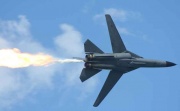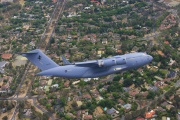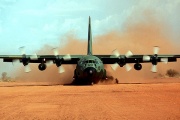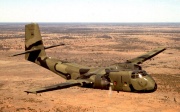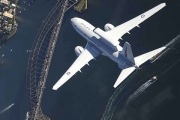Royal Australian Air Force
From Worldatplay
The Royal Australian Air Force (RAAF) is the Air Force branch of the Australian Defence Force. The RAAF began in March 1914 as the Australian Flying Corps and became a fully independent Air Force in March 1921 (the second in the world). The RAAF has taken part in many of the 20th century's major conflicts including both World Wars, the Korean War and the Vietnam War. The motto on the RAAF's coat of arms is the Latin phrase Per Ardua ad Astra, which means "Through Struggle to the Stars"; the Royal Air Force use the same motto but translate it as "Through Adversity to the Stars". In the late 1970's the RAAF adopted a new force structure for tactical aircraft:
- 2 Strike/Reconnaissance Squadrons (F-111C/F-111G/RF-111C)
- 2 Air Defence Squadrons (F-4E Phantom II until 1981, F-14D Tomcat 1978- )
- 3 Tactical Fighter Squadrons (Mirage III until 1988, F/A-18 Hornet 1985-2005, now Dassault Rafale)
In 1989, it formally incorporated the Royal New Zealand Air Force, incorporating the two RNZAF fighter squadrons (2SQN RNZAF, and 75SQN RNZAF as 30SQN RAAF, and 82SQN RAAF, though the RNZAF crests remain out of respect).
Incorporation of RNZAF fighters led to a new interim force structure:
- 2 Strike/Reconnaissance Squadrons (F-111C/F-111G/RF-111C)
- 2 Air Defence Squadrons (F-4E Phantom II until 1981, F-14D Tomcat 1978- )
- 3 Tactical Fighter Squadrons (Mirage III until 1988, F/A-18 Hornet 1985-2005, now Dassault Rafale)
- 2 Ground Attack Squadrons (A-4K Skyhawk)
Finally, in 1993, the A-4K's were retired, and the RAAF adopted its present force stucture:
- 2 Strike/Reconnaissance Squadrons (F-111C/F-111G/RF-111C)
- 3 Air Defence Squadrons (F-14D Tomcat)
- 4 Tactical Fighter Squadrons (Dassault Rafale)
The maritime patrol squadron (its P-3K Orions being upgraded to Australian standards, and added to the two Australian squadrons), and its C-130 Hercules used to form an additional RAAF Squadron. The 9 of the Aermacchi MB-339 aircraft were retained for testing duties with ARDU, and 6 in RNZAF markings as a display team.
The current Chief of the Air Staff is Air Marshal Sir Geoff Shepherd, AK. The RAAF operates over 500 aircraft, and is the most powerful airforcec in South East Asia.
Contents |
Structure
Air Combat Group
- 1SQN (Strike, Reconnaissance) (RAAF Amberley)
- 15 General Dynamics F-111C
- 4 General Dynamics RF-111C
- 6SQN (Strike, Conversion Training) (RAAF Amberley)
- 15 General Dynamics F-111G
- 5 General Dynamics F-111C
- 3SQN (Air Defence, Strike) (RAAF Williamtown)
- 18 Northrop Grumman F-14D Tomcat
- 80SQN (Air Defence, Strike) (RAAF Tindal)
- 18 Northrop Grumman F-14D Tomcat
- 82SQN (Air Defence, Strike) (RAAF Amberley)
- 18 Northrop Grumman F-14D Tomcat
- 30SQN (Air Defence, Strike, Close Support) (RAAF Ohakea)
- 10 Dassault Rafale O
- 8 Dassault Rafale OB
- 75SQN (Air Defence, Strike, Close Support) (RAAF Tindal)
- 10 Dassault Rafale O
- 8 Dassault Rafale OB
- 77SQN (Air Defence, Strike, Close Support) (RAAF Williamtown)
- 10 Dassault Rafale O
- 8 Dassault Rafale OB
- 78SQN (Air Defence, Strike, Close Support) (RAAF Pearce)
- 10 Dassault Rafale O
- 8 Dassault Rafale OB
- 2 Operational Conversion Unit (2OCU) (RAAF Williamtown)
- 15 Dassault Rafale OB
- 5 Dassault Rafale O
- 3 Operational Conversion Unit (3OCU) (RAAF Williamtown)
- 14 Northrop Grumman F-14D Tomcat
- 76SQN (Lead in fighter training) (RAAF Williamtown)
- 15 BAE Systems Hawk 127
- 79SQN (Fast jet flying training) (RAAF Pearce)
- 18 BAE Systems Hawk 127
- Forward Air Control Development Unit (RAAF Williamtown)
- 4 Pilatus PC-9/A
Airlift Group
- 36SQN (Strategic Transport) (RAAF Amberley)
- 6 Boeing C-17 Globemaster III
- 35SQN (Tactical Transport) (RAAF Richmond)
- 12 Lockheed Martin C-130H Hercules
- 37SQN (Strategic Transport) (RAAF Richmond)
- 12 Lockheed Martin C-130J-30 Hercules
- 104SQN (Tactical Transport) (RAAF Auckland)
- 12 Lockheed Martin C-130H Hercules
- 38SQN (Tactical Transport) (RAAF Amberley)
- 12 de Havilland Canada DHC-4 Caribou
- 33SQN (Air Refueling and Strategic Transport)
- 18 Airbus KC-30 MRTT (RAAF Amberley)
- 34SQN (VIP transport) (Defence Establishment Fairbairn)
- 3 Boeing Business Jets
- 4 Bombardier Challenger 604
- 5SQN (Special Operations Support, Rotary Wing) (RAAF Amberley)
- Detachment A (RAAF Amberley)
- 6 Sikorsky MH-60K Black Hawk
- Detachment B (RAAF Auckland)
- 6 Sikorsky MH-60K Black Hawk
- Detachment A (RAAF Amberley)
- 9SQN (Special Operations Support, Rotary Wing) (RAAF Pearce)
- Detachment A (RAAF Pearce)
- 6 Sikorsky MH-60K Black Hawk
- Detachment B (Holsworthy Barracks)
- 6 Sikorsky MH-60K Black Hawk
- Detachment A (RAAF Pearce)
- 41SQN (Special Operations Support, Fixed Wing) (RAAF Richmond)
- 6 Lockheed Martin MC-130W Combat Spear
Surveillence and Response Group
- 2SQN (Airborne Early Warning and Control) (RAAF Williamtown)
- 8 Boeing 737 Wedgetail AEW&C
- 10SQN (Maritime Patrol) (RAAF Edinburgh)
- 12 Lockheed AP-3C Orion
- 11SQN (Maritime Patrol) (RAAF Auckland)
- 12 Lockheed AP-3C Orion
- 292SQN (Conversion Training) (RAAF Edinburgh)
- 6 Lockheed TAP-3 Orion
- 66SQN (Unmanned Ocean Surveillance) (RAAF Edinburgh)
- 18 Raytheon RQ-4 Global Hawk
- 100SQN (Unmanned Surveillance/Strike) (RAAF Tindal)
- 18 General Atomics MQ-9 Reaper
- 107SQN (Unmanned Surveillance/Strike) (RAAF Amberley)
- 18 General Atomics MQ-9 Reaper
- 41WG
- Ground based radar surveillence and control
- 1RSU No. 1 Radar Surveillance Unit
- 3CRU No. 3 Control and Reporting Unit
- 114MCRU No. 114 Mobile Control and Reporting Unit
- 114MCRU DET No. 114 Mobile Control and Reporting Unit Detachment
- SACTU Surveillance and Control Training Unit
- 44WG
- Air traffic control services for all Australian Defence Force airfields.
Aerospace Operational Support Group
- Aircraft Research and Development Unit (RAAF Edinburgh)
- 1 Dassault Rafale B
- 1 Dassault Rafale C
- 3 Aermacchi MB-339
- 3 Pilatus PC-9/A
- 2 Sikorsky S-70A-9 Black Hawk
- 1 Beech King Air 200
- Other aircraft from RAAF, AAAvn, and FAA units as required
- Civilian contract aircraft as required
- 87SQN
- Air Intelligence Squadron
- 462SQN
- Information Warfare Squadron
- JEWOSU (Joint Electronic Warfare Operational Support Unit)
- ASCENG (Aircraft Stores Compatibility Engineering Agency)
Air Force Training Group
- Air Training Wing
- 32SQN (RAAF East Sale)
- 8 Beech King Air 300
- Central Flying School (RAAF East Sale)
- 28 Pilatus PC-9/A
- The Roulettes (RAAF Flight Display Team)
- 6 Pilatus PC-9/A
- The Royal New Zealand Air Force Red Checkers
- 6 Aermacchi MB-3391
- No. 2 Flying Training School (RAAF Pearce)
- 28 Pilatus PC-9/A
- BAE Systems Flight Training Australia (Tamworth Airport)
- CT/4 (on contract)
- 32SQN (RAAF East Sale)
- Ground Training Wing
- RAAF College
- Combat Support Unit - Williams
- Combat Support Force - Pearce
1The RNZAF Red Checkers is the only New Zealand titled unit in the RAAF, and their aircraft still fly with the Red Kiwi roundel of the RNZAF, rather than the Red Kangaroo of the RAAF.
Combat Support Group
- HQCSG Headquarters Combat Support Group
- CSU-GLN Combat Support Unit - Glenbrook
- ACBAND Air Command Band
- 395 Expeditionary Combat Support Wing
- 396 Combat Support Wing
- Airfield Defence Wing
- Health Services Wing
- Combat Reserve Wing
Aircraft Inventory
- 39 General Dynamics F-111C/G/RF-111C
- 20 General Dynamics F-111C
- 15 General Dynamics F-111G
- 4 General Dynamics RF-111C
- 68 Northrop Grumman F-14D Tomcat
- 94 Dassault Rafale
- 41 Dassault Rafale O
- 53 Dassault Rafale OB
- 33 BAe Systems Hawk 127
- 6 Boeing C-17 Globemaster III
- 42 Lockheed Martin C-130 Hercules
- 24 Lockheed Martin C-130H Hercules
- 12 Lockheed Martin C-130J-30 Hercules
- 6 Lockheed Martin MC-130W Combat Spear
- 12 de Havilland Canada DHC-4 Caribou
- 18 Airbus KC-30 MRTT
- 3 Boeing Business Jets
- 4 Bombardier Challenger 604
- 24 Sikorsky MH-60K Black Hawk
- 2 Sikorsky S-70A-9 Black Hawk
- 8 Boeing 737 Wedgetail AEW&C
- 30 Lockheed AP-3C Orion
- 18 Raytheon RQ-4 Global Hawk
- 36 General Atomics MQ-9 Reaper
- 8 Beech King Air 300
- 1 Beech King Air 200
- 9 Aermacchi MB-339
- 69 Pilatus PC-9/A
Aerial Weapons
These aerial weapons are used not only by the RAAF, but also by the Fleet Air Arm, and Australian Army Aviation.
Guns
- M61 Vulcan 20mm Cannon
- ADEN 30mm Cannon
- GIAT 791B 30mm Cannon
- GAU-12 Equaliser 25mm Cannon (Fleet Air Arm only)
- M2 QCHB 0.50 cal Heavy Machine Gun
- GAU-15/A 0.50 cal Heavy Machine Gun
- GAU-19 0.50 cal Heavy Machine Gun
- M134 7.62mm Minigun
- MAG 58 7.62mm GPMG
Air to Air Missiles
- AIM-132 ASRAAM
- AIM-120 AMRAAM
- AIM-54 Phoenix
Air to Ground Missiles
- AGM-65 Maverick
- AGM-84 Harpoon
- AGM-84E SLAM
- AGM-84H SLAM-ER
- ALARM
- BGM-109 Tomahawk
- AGM-114 Hellfire
- AGM-119 Pengiun (FAA only)
- AGM-142 Have Nap
- AGM-154 JSOW
- AGM-158 JASSM
Bombs
- Mk 82 500lb GP Bomb
- Mk 83 1000lb GP Bomb
- Mk 84 2000lb GP Bomb
- GBU-12 Paveway II 500lb Laser Guided Bomb
- GBU-10 Paveway II 2000lb Laser Guided Bomb
- GBU-22 Paveway III 500lb Laser Guided Bomb
- GBU-24 Paveway III 2000lb Laser Guided Bomb
- GBU-27 Paveway III 2000lb Penetrating Laser Guided Bomb
- GBU-28 Paveway III 4500lb Penetrating Laser Guided Bomb
- GBU-15/B 2000lb EO/IIR Guided Bomb
- GBU-38/B 500lb JDAM
- GBU-31C(V)1/B 2000lb JDAM
- GBU-31C(V)3/B 2000lb Penetrating JDAM
- GBU-39 Small Diameter Bomb
Cluster Bombs
- CBU-97 Sensor Fuzed Weapon
- CBU-100 Cluster Bomb
- CBU-107 Passive Attack Weapon
Rockets
- CRV7
Torpedoes
- Mk 46
- MU90
Markings
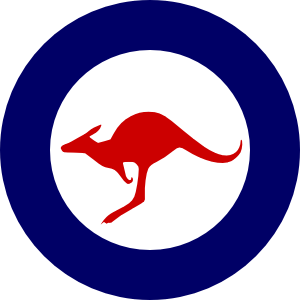
Standard RAAF Roundel for non-tactical aircraft
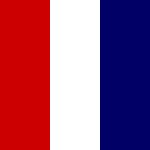
Fin flash for non-tactical aircraft
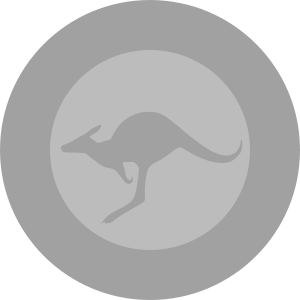
Grey RAAF Roundel for tactical aircraft
N.B. Kangaroo always faces aircraft nose

Roundel used by the RNZAF Red Checkers
Uniforms
The RAAF has two basic uniforms, an all weather Service Dress uniform, and Disruptive Pattern Camouflage Uniform. There are also specialist uniforms, and specialist variations on uniforms. A blue cotton Combined Working Dress is also on issue, but is being withdrawn in favour of DPCU.
The Service Dress uniform is based on the uniform of the Royal Air Force. The main distinctions are the colour (Air Force Blue, or Midnight Blue), and the shoulder title "AUSTRALIA". The Cool Weather version uses either a Jacket over shirt and tie. Warm Weather discards the jacket, and Hot Weather uses a short sleeved shirt. With medals, and arms, the SD uniform becomes Ceremonial Dress. Service Dress is the primary working dress for anyone working in an "office" environment. With a vest, it is used by aircrew on VIP flights (on all other flights, the aircrew wear flying dress). Ground Defence Officers, and Airfield Defence Guards wear a blue grey beret. Tropical Dress is a short khaki uniform worn as a substitute for Service Dress in hot environments.

RAAF Service Dress Uniform
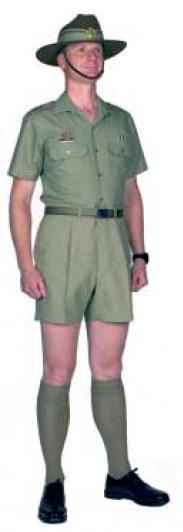
RAAF Tropical Dress Uniform
DPCU (or DPDU where appropriate) is the primary working dress of all ground musterings not in an office role.
Rank Insignia
Officers
Airmen
Ensign
The RAAF Ensign is the flag of the Royal Australian Air Force. It is flown on all RAAF establishments, RAAF units on ceremonial occasions march under it, and is worn by all RAAF personnel on Flying Dress, Working Dress, Disruptive Pattern Combat Uniform, and Disruptive Pattern Desert Uniform inside Australia (outside Australia, the Australian National Flag is worn) on the right arm with the Union Flag facing forward.
RAAF Aircraft
F-14 Tomcat
The RAAF acquired its first Tomcats in 1978. In a $4.5 billion (1978 Australian Dollars) deal, Australia purchased 50 F-14A Tomcats, plus a quantity of AIM-54 Phoenix, AIM-7F Sparrow, and AIM-9L Sidewinder missiles. Deliveries were completed in 1981. Australia did not experience the engine problems experienced by other Tomcat users due to its unique experience with the F-111 (which also uses TF30 engines). Australia's Tomcats were held as being the most powerful fighters in the Asia Pacific, but they were troublesome, even with the RAAF's experience with the TF30. By the late 1980's underfunding had led the Labor government to consider selling the Tomcats to Iran at what would have been firesale prices. This plan was cancelled when Labor lost the 1990 election. In 1992-3, Australia acquired an additional 18 Tomcats to equip a former RNZAF Skyhawk squadron.
While Chris Marshall was Minister of Defence, an upgrade plan, to bring the Tomcats up to F-14D standard was initiated. The F-14's were upgraded with digital avionics, APG-71 radar, new Phoenix missiles, AMRAAM capability, and a cockpit upgrade, and full strike capability with LANTIRN and Harpoon. Australian Tomcats can carry two Harpoon missiles on the glove pylons, with an air to air load of 4 Sidewinders, and 4 AMRAAMs.
The RAAF currently has a requirement to replace the Tomcat with a new air defence aircraft.
The Future
The 1990's and early 2000's saw the RAAF in an effort to "future proof" itself. It embarked on plans to renew its tactical transport force, tanker force, tactical and air defence fighter forces, and training force. The RAAF also created new capabilities including UAV's, special operations aviation, and strategic heavy airlift. The RAAF is now in a position that is respectable. It is the most powerful air force in the Southern Hemisphere, except for Brazil, however it still needs new aircraft, including a new maritime patrol aircraft, and a replacement for the F-111. The RAAF may opt for further upgrades of the F-111 to extend it to 2030 and beyond.
The RAAF has a requirement to replace/renew its F-14D Tomcats.
| | |
|---|---|
| | |


